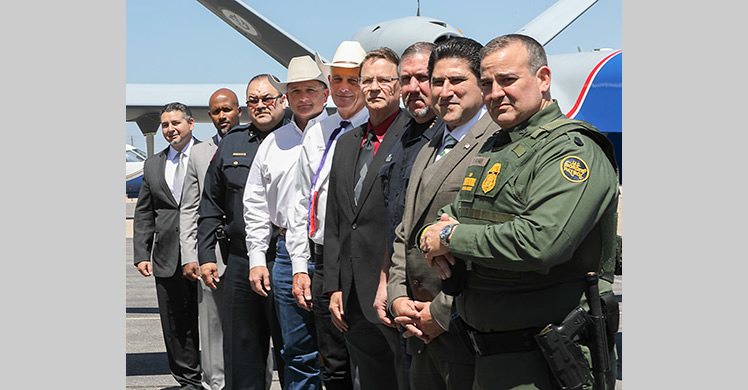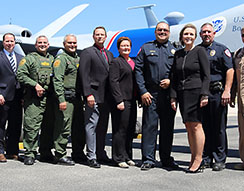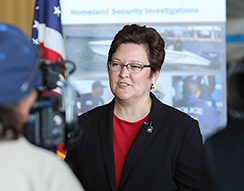Archived Content
In an effort to keep ICE.gov current, the archive contains content from a previous administration or is otherwise outdated. This information is archived and not reflective of current practice.
Latest 'BEST' task force established in West Texas
SAN ANGELO, Texas — To help combat the many and varied crimes associated with Transnational Criminal Organizations, U.S. Immigration and Customs Enforcement (ICE) is establishing its 58th “BEST” task force in the United States, and its eighth in Texas.
The new “West Texas Panhandle Border Enforcement Security Task Force,” (BEST) based in San Angelo, is designed to formalize and enhance already-existing relationships with local, state, federal and tribal law enforcement agencies to combat Transnational Criminal Organizations (TCO). This latest BEST task force extends from Crockett and Sutton counties in central Texas all the way north to the southern border of Oklahoma.
Crockett and Sutton counties are just one county north of the border with Mexico. Drug and human smugglers, gangs and other criminals who travel farther west to avoid law enforcement on the main Interstate Highway 35 corridor starting in Laredo, Texas, still have to contend with the West Texas Panhandle BEST.
“The Tom Green County Sheriff’s Office is looking forward to working with our partners in BEST to be more effective in combating illegal activities in our communities,” said Sheriff David Jones, Tom Green County, Texas. “Working together with federal, state and local agencies will benefit all involved as being a force multiplier in our efforts to enforce all federal and state laws.”
“With shrinking budgets, few employees, and increasing crime, this Task Force can increase a department’s capability to fight crime with additional resources,” said Sheriff Ricky Bishop, Taylor County, Texas. “With the ability to share information and work closely with other agencies, we are able to do more than we could if we were having to work alone.”
In addition to HSI, following are the current members of the new BEST task force:
- U.S. Attorney’s Office, Northern District of Texas, Abilene Division;
- U.S. Customs and Border Protection (CBP), Del Rio Air Branch;
- ICE Enforcement and Removal Operations, San Angelo Suboffice;
- CBP U.S. Border Patrol, Rocksprings Station;
- U.S. Marshal’s Service;
- Federal Bureau of Investigations (FBI), Abilene Office of the Resident Agent in Charge;
- Texas Department of Public Safety’s (DPS) Criminal Investigative Division (CID), San Angelo;
- Taylor County Sheriff’s Office, Abilene, Texas;
- Tom Green County Sheriff’s Office, San Angelo;
- Big Spring (Texas) Police Department;
- Sonora (Texas) Police Department;
- U.S. Probation and Pretrial Services, San Angelo;
- San Angelo Police Department
The West Texas Panhandle BEST operates as a second front to law enforcement that currently work along the U.S.-Mexico border. Although HSI has already been working with many of the law enforcement agencies now part of the latest BEST team, the formalized BEST concept offers a means for these partners to obtain overtime pay (as required), specialized equipment and training, and asset-sharing of funds seized from criminal organizations. The new BEST task force will work to maximize the effectiveness of each individual law enforcement agency through all cooperating law enforcement agencies.
The BEST investigative model is a comprehensive response to the growing threat to border security, public safety and national security. BESTs eliminate the barriers between federal and local investigations, and close the gap with international partners in multinational criminal investigations.
BESTs also create an environment that minimizes the vulnerabilities in our operations that TCOs have traditionally capitalized on to exploit our nation’s land and sea borders.
BEST Background
In 2005, HSI created the first BEST in Laredo, Texas, in partnership with U.S. Customs and Border Protection (CBP) and other federal, state, local and international law enforcement agencies. BEST Laredo represented HSI’s first combined, direct response to growing violence along the Mexican border, and established the baseline for implementing the program elsewhere.
The success of the BEST investigative model is predicated on all BEST partner special agents and Task Force Officers (TFO) working together in one location, recognizing and leveraging a threat-based risk-mitigating investigative task force model. The model leverages the unique resources and abilities of all participating law enforcement partners, and the availability to designate partner law enforcement officers with Title 19 customs authorities. This has led to expanding the BEST investigative model to northern border and commercial seaport locations.
BEST Today
BEST special agents and TFOs investigate a wide range of criminal activity with a nexus to our land and sea borders, to include drug trafficking, arms trafficking, human trafficking and smuggling, gangs, money laundering and bulk cash smuggling, child exploitation, maritime smuggling, illicit tunnels and commercial fraud.
BESTs are located along the northern and southwest land borders, major seaports, and international airports from Hawaii to Puerto Rico. These BESTs comprise about 1,000 members representing more than 100 federal, state, local, tribal and international law enforcement agencies that have jointly committed to investigate transnational criminal activity and enhancing border security.
Jaime Zapata BEST Act
In December 2012, President Barack Obama signed into law the Jaime Zapata Border Enforcement Security Task Force Act. The law was named in memory of Jaime Zapata, an HSI special agent assigned to a BEST who was killed on duty in Mexico. This law amends the Homeland Security Act of 2002 to formally establish the BEST program and authorizes the Secretary of Homeland Security to direct the assignment of federal personnel to the program, as well as take other actions to aid federal, state, local and tribal law enforcement agencies in participating in such task forces.
BEST Partners
BESTs incorporate personnel from:
- Department of Homeland Security (HSI, ICE Enforcement and Removal Operations; CBP Offices of Field Operations, Border Patrol, and Air and Marine; U.S. Coast Guard and U.S. Secret Service);
- Department of Justice (Drug Enforcement Administration; Bureau of Alcohol Tobacco Firearms and Explosives; FBI and U.S. Attorney’s Offices);
- Department of Defense (Army Criminal Investigations Command, Defense Criminal Investigative Service, Naval Criminal Investigative Service and state National Guard units);
- Department of the Treasury (Internal Revenue Service’s Criminal Investigations);
- Other federal partners;
- More than 100 state, local and tribal law enforcement agencies; and
- International law enforcement agencies.





